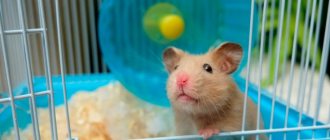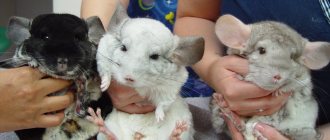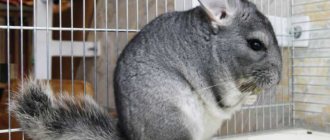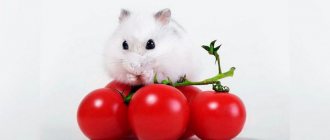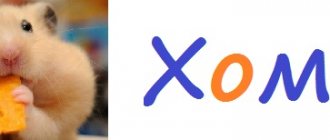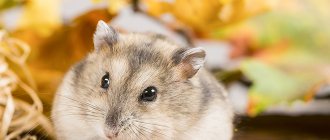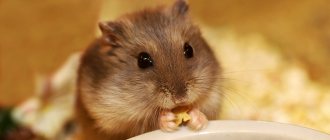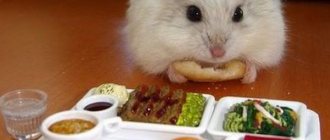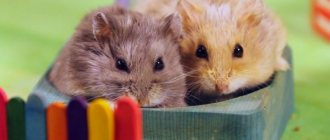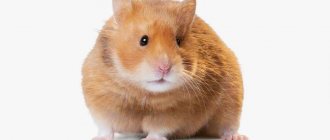- home
- Nutrition
29.03.2018
The usual diet for a hamster consists of grains mixed with healthy flakes. Many owners sometimes make changes in the form of lush greens or vegetables. But not all rodents are able to eat the food that humans prefer to buy. Can hamsters eat radishes? This article will tell you about the benefits and harms of the vegetable, as well as the effect on the animal’s body.
What should you not feed hamsters?
We have already written that domestic hamsters should absolutely not be given
any exotic fruits, hot, salty, peppery or too sweet, as well as fatty foods, for which the animal’s small digestive system is not designed at all.
This means that honey, any sweets, kozinaki, ice cream, halva and shortbread dough are contraindicated for a hamster: for a pet this is a slow-killing poison. The rodent's diet should be free of any milk, butter, cream, kefir and sour cream. Cabbage, fried meat, chocolate products, pasta, bread, breadcrumbs are contraindicated for your pet, as they contain an ingredient that is dangerous for the hamster. Yes, yes, don’t be surprised, hamsters should absolutely not be given bread, only grain.
Naturally, garlic, hot peppers, onions, and sorrel should not be given to a rodent. Do not forget about melons and watermelons, as well as apricot or cherry pits, which contain acid that is harmful to the hamster.
Every time, make sure that the hamster eats only fresh, unspoiled food and feed, ripe fruits and vegetables, and has the required amount of fresh water. This is the only way your playful pet will delight you and your family for a long time with its cheerfulness, activity and healthy appearance!
Apples are one of the most popular fruits in our latitude. We meet him almost every day in shops, bazaars, and in our own garden. It is a relatively cheap, easily accessible, tasty food for many pets.
What foods are strictly prohibited in the diet?
Owners do not always understand whether foods are harmful or beneficial for a hamster; they feed their pet food that causes great damage to its health. Below is a list of food that should never end up in your animal’s feeder. It includes:
- sour cream, cheese, cream, butter;
- sugar, chocolate, ice cream, sweets, baked goods;
- salt, spices, herbs;
- dry food for other animals;
- acorns, chestnuts, almonds, Brazil nuts;
- citrus fruits, seeds of cherries, cherries, apricots and other fruits;
- lard, red meat, fatty fish;
- mushrooms;
- potatoes, cabbage of all varieties;
- sorrel, garlic, onions, pine needles, tree branches;
- any juices;
- unknown insects, independently caught in nature.
What kind of apples can you give?
Hamsters can eat apples and even need them, but on the condition that the fruits are fresh:
- will be ripe;
- not treated with chemicals and various growth stimulants;
- before offering such food to a rodent, it must be thoroughly rinsed under running water;
- It is recommended to soak fruits purchased at the supermarket in water for several hours to neutralize the effects of pesticides.
Offer your pet apples of sweet and sour varieties. They are more useful and do not have a negative effect on the animal’s gastric mucosa. Can hamsters have sweet apples? Fruits with a high content of sucrose are harmful for such a pet. They can provoke the development of diabetes and related diseases.
You can give hamsters apples, but only after they reach one month of age. At an earlier age, eating this fruit can cause diarrhea, vomiting and gastrointestinal upset.
When offering this product to your furry, do not forget that it contains seeds. Fruit pits are contraindicated for hamsters because they contain a toxic substance - hydrocyanic acid. Therefore, before giving them to the animal, cut them in half and remove the entire core of the fruit.
Both Syrians and Dzungarians can eat apples. Almost all breeds of the Hamyakov family can eat this delicacy with great pleasure.
Dried apples
Many livestock breeders are interested in whether hamsters can eat dried apples? Of course you can! The hamster will be happy to eat such a treat. The main thing is that the drying is prepared correctly, and always without adding sugar and salt. In dried form, such a product does not lose its valuable properties and qualities. Dried apples normalize metabolic processes and prevent the development of gastrointestinal diseases.
Baked and stewed apples
As for baked and stewed apples, it is not recommended to give them to your pet. This product is of little use to your pet hamster. In addition, it can cause discomfort and pain in the stomach and intestines. As a result, your hamster may experience vomiting, nausea, and diarrhea.
Social structure and reproduction
Photo: Syrian hamster
Golden hamsters are very prolific animals, provided they are kept in optimal, comfortable conditions. If the temperature of the space surrounding them is maintained at 20-25 degrees, animals will be able to bear offspring almost all year round. Most often, with good care, a sexually mature female individual bears offspring 3-5 times a year. She can give birth to 5 to 9 babies at the same time.
The period of sexual maturity in males occurs at the age of one month, and in females at the age of two months. It is recommended to breed animals to produce offspring after the female has gone into estrus. Otherwise, individuals can seriously fight, even causing injury to each other. If the hamsters like each other, then they mate successfully. The whole process lasts no more than 10 minutes. Pregnancy may not occur the first time. Then a second mating will be required.
Pregnancy lasts on average 17-18 days. When the time comes to give birth, the female goes into the nest or shelter she has made. The mother feeds newborn babies with milk for another month. After the male has impregnated the female, they must be separated, since pregnant females are characterized by aggressive behavior towards their relatives. The owner should also be careful, since during this period the animals tend to bite.
What are the benefits of cherries?
Is it possible to give this berry to rodents? Definitely yes. After all, it contains large quantities of useful substances necessary for his body. Vitamin C, which is present in abundance in berries, strengthens the immune system and increases the body's resistance to colds and infectious diseases. Accelerates the healing process of wounds, regulates the process of hematopoiesis. The berry has a positive effect on kidney function, acts as a diuretic, and removes excess fluid from the body. If your hamster suffers from cystitis, pyelonephritis or other urinary tract diseases, including this product in the diet will be very beneficial for him. It has a beneficial effect on the gastrointestinal tract, kills pathogenic microbes, improves metabolism, and stimulates gastric motility. Acts as a laxative for constipation. Promotes rapid bowel movement and removes toxins. Berries should be given to hamsters with various bone diseases (arthritis, arthrosis), because they contain carotene, which helps strengthen bones, teeth, and the nervous system. It also acts as a natural pain reliever.
Is it possible to give this treat if you have dysbacteriosis? Berry juice has a beneficial effect on intestinal microflora, relieves pain and inflammation. It has antibacterial properties and stops the putrefactive process in the body.
In small quantities, the product is very useful for hamsters of the third and fourth year of life, because the berry promotes the secretion of gastric juice and improves appetite.
The acids in the berry help improve the absorption of protein and iron, which, in turn, protects the animal from anemia and anemia. Flavonoids and antioxidants prevent cell mutation and prevent the growth of cancer cells. The product contains a large amount of iodine. Its consumption promotes the positive functioning of the central nervous system and endocrine system. Improves the functioning of the thyroid gland. Potassium regulates heart function. Magnesium saturates the body with oxygen.
This is a dietary product. 100 grams of the product contains only 50 kcal, so the berry can be safely included in the diet of overweight animals.
The berries do not lose their medicinal properties after freezing. In the spring-autumn period, when the animal’s body is susceptible to vitamin deficiency, the berry is an excellent preventive measure.
Consequences of eating prohibited root vegetables
When animals eat radishes, the following signs may be observed:
- Increased gas formation, bloating.
- Diarrhea, abdominal pain.
- Vomit.
In advanced cases of flatulence, negative consequences may develop, for example, volvulus. In this case, surgical intervention is required.
If there are warning signs, you can take the following actions:
- Gastric lavage in large animals.
- You can give the affected animal medications that eliminate flatulence and bloating.
- Feeding something sweet will partially neutralize the mustard oil found in radishes.
- The use of enveloping agents also has a positive effect.
Which hamster is better: Djungarian or Syrian
Both Djungarian and Syrian hamsters need proper care. To understand which hamster is best to get, the future owner must take into account his character and lifestyle.
If the owner spends the whole day at work or periodically leaves home for 1–2 days, then a dzhungarik will be more suitable for him. It is better to buy 2 hamsters from the same litter and place them in a spacious cage with separate accessories, then they are unlikely to conflict. If you provide them with food and drink, they will not even notice the absence of a person.
If the future owner wants to have contact with the animal, then the Syrian hamster will become an excellent friend. Some owners allow the animal to spend all its waking hours in freedom; they are sent into the cage only to sleep
The golden hamster meets the owner if he has gone somewhere, climbs into his arms, and attracts attention to himself
Parents are always unsure which hamster is better to buy for their child - Djungarian or Syrian. If the future owner is under 5 years old, then it is recommended to choose a Syrian.
He is larger, phlegmatic, and has good contact with people. But it is better to buy a pet no younger than 2 months. Using the example of a calm animal, a child will learn to care for rodents: clean the cage, feed.
Djungarians can easily escape from their little owner if he opens the cage to change the bedding or put in food
In addition, the latter can bite the child if handled carelessly, then stress is guaranteed for both
Which hamster is suitable for a child over 5 years old, he will decide for himself. The main thing is to teach him to be responsible and treat animals with care. Adults should supervise the care process.
The Syrian hamster is more suitable for children, as they love to cuddle, pet, play, and train. In addition, they live longer, and Djungarians often do not live up to 2 years
Thus, Djungarians are more suitable for adults who do not need physical contact, are often not at home, and can keep 2 pets. Syrian hamsters will bring joy to children and adults who want to pet, hold and train the animal.
In both cases, you need to provide the hamster with spacious housing, necessary accessories, proper care, care and love.
Choosing and arranging housing
Choosing housing for your pet is not a problem these days: pet stores provide a huge selection to suit every taste and budget. The optimal cage size for a Syrian hamster is 60x40x25. The bars in such a cage are located vertically, which will allow the pet to climb on them - this is one of his favorite activities; the width between them is 10 millimeters for this breed.
If for some reason you have chosen a plastic aquarium, its dimensions should be 50-60x40x30-40 centimeters.
Its well-being and life expectancy largely depend on the equipment of a hamster’s home.
Litter
Wooden sawdust of medium fineness is well suited for bedding. To the same extent, pressed sawdust sprinkled with shavings would be appropriate. This material has good properties; it absorbs moisture and odor.
The following materials are not suitable for bedding:
- napkins;
- cotton wool;
- rags;
- newspaper.
Toilet
Hamsters are well accustomed to a tray that can be purchased commercially - a special one for use by small rodents.
Along with the tray, it is worth purchasing a special filler, which is small granules that perfectly absorb unpleasant odors. This option, although it requires some investment, is the most convenient for the rodent owner. The filler in it usually requires replacement no more than once a week.
Did you know? Hamsters are very smart, amenable to training and can learn several funny tricks, the performance of which will bring joy to both the animal and its owner.
If you bought a young hamster, it will not be difficult for you to accustom him to the litter box, but if the animal has reached adult hamster age and already has his own concept of the toilet, you will not be able to retrain him, you will have to provide him with the toilet to which he is accustomed.
Manholes and wheel
In nature, a hamster’s personal territory is very vast; it is unlikely that it will be possible to recreate such conditions for a pet in an apartment or even a house.
Did you know? In one night, a hamster is able to “run” around the cage up to 12 kilometers, while developing a speed of up to 3.6 km/h.
For climbing in the cage, install:
- tree;
- special tubes;
- labyrinths;
- branches or roots.
The running wheel is selected based on the size of the pet.
It is attached to the wall of the cage or installed freely and allows the animal to “wind up” the mileage it needs. The wheel must have transverse protrusions and a non-slippery bottom without a grid. Important! Any wooden parts brought from the street for a pet should in no case be affected by rot, fungi and other pathogenic microorganisms.
In any case, even if the wood appears healthy, it should be subjected to special disinfection treatment before offering it to your pet. Holiday house
Special housing that plays the role of a hole for a hamster should not be too small. The pet will sleep there and, most likely, will store food supplies.
It is convenient if this device is attached to the cage wall, easily removed and opened for washing and disinfection. The material should not be varnished wood, low-quality plastic or any other substance whose particles can harm the animal’s digestive system.
Did you know? In nature, one hamster is able to make a huge food supply
-
up to 90 kilograms of all kinds of food!
Some individuals prefer to build a nest of sawdust right at the bottom of the cage, ignoring the proposed devices.
Drinking bowl
The volume of the water container should be small, about 50 ml. The water must be changed every day, regardless of how much your pet drinks.
Some rodents do not like water at all; they satisfy their thirst with succulent food.
Important! It should be noted that the hamster will constantly move the bowl of water, splashing out its contents and moistening the bedding material. This situation must be excluded
—
a moist, warm environment is ideal for the development of pathogens. Feeder
This device can be bought or made with your own hands. Its width ranges from 3 to 10 centimeters, depending on the size of the pet, the height of the side is 1.5 centimeters. A medium-sized lid is suitable for this purpose.
Composition of the fruit
Apple fruits are considered one of the most common in temperate regions. There are many varieties of apples and all of them are beneficial for the human body. But is it possible to give hamsters apples and how beneficial are they for the small rodent’s body?
The fruits of the fruit tree are a valuable source of ascorbic acid, potassium and iron. In addition to these useful components, the apple contains zinc and copper.
Varieties grown in the southern regions have a moderate content of fructose and sucrose. Apple trees growing in the north produce fruits with high acidity.
Vegetables
Vegetables are very healthy by nature, they have a lot of vitamins and fiber. But not everyone is suitable for the diet. Some can cause negative reactions in the body or even provoke an allergic reaction. Therefore, when creating a menu, be extremely careful.
Every day you can give:
- Carrots and peppers. They contain microelements that will greatly help in the prevention of age-related diseases. The high acid content will help weakened immunity.
- Peas and beans. They will give the hamster huge reserves of protein with vitamin B. They improve metabolism. Lots of other vitamins and minerals.
- Squash and cucumbers. They will restore the amount of fluid in the body, the peel will provide vitamins and microelements.
There should also be other vegetables on the menu, but there is no need to overdo it so as not to harm your pet. Pumpkin products can be given very rarely due to the higher amount of sugar.
What is it strictly forbidden to feed?
Regular cabbage or its stalk can cause diarrhea. Horseradish will consume a lot of water. If you include heads of garlic and onions in your menu, the chance of allergies will increase. Regular potatoes cause stomach problems, but they can be given boiled. When feeding, you need to chop everything very finely. Store in a cage for a maximum of six hours.
Pregnant females
When preparing for breeding, you should know that a pregnant female needs:
- boiled chicken meat;
- boiled yolk;
- skim cheese;
- greens, sprouted grains;
- increased amount of protein food: gammarus, earthworms, grasshoppers, butterflies (necessarily purchased in specialized pet stores).
During the gestation period, the volume of feed is increased so as not to cause concern to the mother due to lack of supplies. A piece of coal, a mineral stone, and calcium gluconate are placed in the cell.
Pregnancy lasts about 20 days. 5-15 babies are born. Fertilization of a female should not be allowed before four months.
It is important to provide the mother with peace: there should be no other hamsters in the cage, it is forbidden to pick up small cubs, because a foreign smell can frighten the mother. It is necessary to provide the female with a balanced diet and ensure peace. All this will prevent manifestations of cannibalism on the part of the mother.
Choosing a variety
Which variety to choose for dzungaria and do you need to process the fruits? There is no need to choose varieties that are too sweet; your pet will like them, but they can be harmful to health. Too sour fruits are also not suitable; ripe, moderate-tasting fruits are best. If you choose a fruit that is not ripe enough, the animal may have digestive problems.
Regarding processing, the rules are:
- Store-bought apples must be peeled; the fruits may be treated with chemicals. This condition especially applies to fruits purchased in winter. In cold weather, it is better not to buy them for your pet.
- Homemade fruits must be washed.
- Dried apples are better for winter. Soak them in water before giving them to your hamster.
- Fruits must be washed thoroughly under running water.
What do you need to care about most?
While there are seeds and nut-based foods available for hamsters, it is important to know the dangers this class of foods poses to your little pet. Some fruit seeds (also known as pits) are downright toxic to both hamsters and humans.
Those that are not toxic in the immediate sense may be toxic in the long term. This is due to the high content of fats and oils. Some veterinarians complain about cheap commercial food blocks, which are compressed masses of nuts and seeds. According to them, it is better for poultry than for hamsters, as stated on their labels.
Fruit pits, such as the pit inside an unprocessed cherry, do contain harmful toxins. However, don't place them even near your pet to prevent an opportunistic individual from isolating him while you're not looking.
A hard cherry pit also poses a choking hazard to your pet due to the small size of its throat. The same goes for the edible portions you give your pet. Cut the cherry pulp into small pieces that can fit comfortably in your mouth. This way you can avoid the risk of suffocation. Use the physical size of the kibble as a general guide.
Fruits for your hamster
Hamsters can be given various fruits (with the exception of citrus and exotic ones), but in small doses. The high sugar content makes this complementary food unsafe. Domestic Djungarians are given less of it than individuals of the Syrian breed - within 5% of the main diet. Campbell's hamsters are fed even more carefully.
The main fruit products that are suitable for Syrian and Djungarian hamsters include:
- apple - choose sweet and sour varieties, introduce them from 4 months, do not give to lactating females;
- apricot – a little and not overripe, it is better to give dried apricots out of season;
- peach is better than nectarine, it has less sugar;
- pear – firm yellow or green, uncommon;
- banana – preferably a little greenish, just unripe;
- plum - a little at a time, so as not to provoke diarrhea;
- melon – due to excessive sweetness, allowed only once every 5-7 days;
- watermelon - also rare, but from your own garden (it’s hard to find a store-bought one without nitrates).
Berries will help diversify your diet. Strawberries are offered once every 7 days, a piece with a diameter of 1 cm. The rest of the berries from the list are given 1 piece per week, the portion for the Syrian hamster is doubled. Allowed:
- cherries and sweet cherries (pits removed);
- currant;
- not sour gooseberries;
- grape;
- raspberries;
- blueberry;
- blackberry;
- cowberry;
- blueberry.
Of all of the above, only dietary fruits are suitable for Campbell's hamsters. These are nectarine, blueberry, lingonberry, cherry, hawthorn. It is worth remembering that exotic fruits (mango, avocado, kiwi, pineapple and others) are prohibited from being offered to all rodents. They can cause severe allergic reactions and digestive problems.
Meeting a furry animal
The Syrian hamster is a rodent belonging to the hamster family. Its other name is “golden hamster”, which it received due to its reddish-yellow fur. Animals of this breed can be colored not only golden, but also white, brown, black, and silver. The classic Syrian hamster is short-haired, but currently long-haired variations of this species have also been bred. The length of the body of Syrian hamsters ranges from 13 to 18 cm, weight fluctuates around 100-200 g.
The rodent's body is stocky, its legs are short, its ears are rounded, its muzzle is short, its eyes resemble convex beads, and it has a short tail, which is not easy to find in the thick fur. The abdomen is lighter than the back, like all rodents. The hind feet have five toes, the front feet have four, and there is also a rudimentary fifth. A distinctive feature of hamsters is their cheek pouches; the Syrian breed also has them, and it uses them fully. The active phase of an animal’s life in nature occurs at night.
Before getting any pet - be it a turtle, snail, rabbit, jerboa, degu, guinea pig, siskin, crossbill, parrot - you should study the features of caring for it.
The animals are clean and hardy. They are active, funny and curious, become attached to their owner and can be trained, and do not show aggression towards people. Females have virtually no scent, but males prefer to carefully mark their territory.
First described in the late 18th century, the Syrian hamster has a long, fascinating and intricate history of distribution, breeding, study and selection.
Did you know? The Syrian hamster was listed in the Red Book as an endangered species.
Why are cookies harmful?
Hamsters have a very low tolerance for sweets, salty and fatty foods. Especially harmful for Djungarian hamsters, which are predisposed to diabetes. You can occasionally offer your hamster dry, unsalted biscuits. But we are not immune from the fact that even such store-bought cookies contain a lot of harmful additives and chemicals. They have a detrimental effect on the liver and digestive tract of the rodent. Salt, which is very high in crackers, damages the heart and kidneys. As a result, the immune system weakens and other vital systems suffer. A hamster with a cookie looks very cute, crunches funny, and crumbs remain on its antennae. But you shouldn’t risk your pet’s health to admire this picture; it’s better to choose a healthy alternative to the treat.
Walking around the apartment
A hamster walking around the apartment faces many dangers:
- He can pick up an infection brought by people or other animals with street dust.
- Burying itself under a carpet or blanket, or simply tucked under your feet, a small animal runs the risk of being crushed or slammed by a door.
- Being a flatland dweller, the rodent is completely devoid of fear of heights, which can play a cruel joke on it.
- An animal can pick up something from the floor that is inedible and/or poisonous to it; how much does such a baby need?
- A rodent can chew through wires, at a minimum damaging them and at a maximum receiving an electric shock, even a small voltage of which can be fatal.
- If there is another animal in the house, especially a predator, it poses a constant potential threat to the rodent, even if they coexist peacefully in the same space, so leaving the hamster alone with other pets is undesirable.
It is relatively safe for a hamster to walk around the apartment in a special walking ball, but it should still be released under supervision and for a short time.
It is better to organize a pen with an area of a square meter for the hamster, in which there will be a fence that does not let him outside, and the pen itself will be equipped with toys and hamster devices that can entertain the pet and provide proper physical activity.
The importance of fruits and vegetables for rodents
Fruits and vegetables are a source of nutrients not only for people, but also for their pets. Eating fresh vegetables normalizes the functioning of the digestive system. Fruits are a healthy treat that your hamster cannot refuse. Pets are fed plant products not only to satisfy hunger, but also to prevent vitamin deficiencies.
Vegetables and fruits are beneficial for hamsters because they contain:
- water;
- nutrients that provide energy;
- vitamins necessary to maintain immunity;
- minerals involved in metabolic processes;
- fiber that improves digestion.
All these components are necessary for the health of the pet. A long-term absence of one of these components leads to the development of various diseases.
A little about the dangers of tomatoes for a hamster
Fresh tomatoes have a lot of liquid. If you feed them to your hamster uncontrollably, the load on the kidneys will greatly increase and intestinal function will be disrupted. This will not lead to anything good. Moreover, you should not give your hamster fruits bought in a store. Especially if they are “overseas”. All these products are grown using only chemical fertilizers. Essentially, this is a conveyor belt where you need to grow quickly and sell quickly. It's not our concern anymore. And for better preservation and appearance, they are also coated with all sorts of chemicals. compositions. Like in McDuck, where the potatoes don’t rot for years. As a result, instead of useful minerals, the hamster eats a decent amount of nitrates and other chemicals.
The ideal tomato for a hamster is the one you grow yourself. In your beds or on the windowsill. Which is without chemicals. It definitely contains vitamins and this tomato can be safely given to a hamster.
This concerns “fresh” tomatoes. Now another question arises: can a hamster have canned tomatoes? The answer is no.
Source
Apples for dwarf and Syrian hamsters
Since dwarf breeds of domestic rodents have some health characteristics, before you treat them to an unfamiliar product for the first time, you need to find out whether Djungarian hamsters can eat an apple.
Yes, this is a healthy addition to your baby's diet.
You just need to start giving the dwarf an apple carefully - with a small piece. If the body responds well to the new food, more treats can be given.
To the question whether it is possible to give apples to Syrian hamsters, the answer is also positive. You can offer them to your baby following the usual recommendations.
Apples are useful for any breed of domestic rodent. This is a good addition to the main diet and a tasty treat, but you need to feed babies this juicy, aromatic fruit, observing small restrictions. Then your pets will delight you with health and cheerfulness for a long time.
What other vegetables from your own garden can you pamper your hamster with? Read about this in our articles about whether it is worth giving a hamster a pear and why it is important to give hamsters a tomato. https://www.youtube.com/embed/tgfGaUem1UU
Where does the Syrian hamster live in the wild?
As for the distribution area of animals, it is quite extensive. Syrian hamsters are common on the European continent, Africa, Central to Southeast Asia, and North and South America.
There is no preferred habitat for these rodents. They feel equally comfortable in semi-deserts and deserts, in forest-steppe areas and steppes, in mountains at an altitude of up to 3000 m above the sea.
But most often the animal can be found in the wild in cultivated areas, orchards, parks and fields in countries such as the Balkans, Turkey, and Iran.
These rodents are completely unpretentious, so they can actually live in any area where there is suitable food.
Rules for feeding permitted products
The diet of Djungarian hamsters should be varied: the same foods should not be given day after day (except for dry food). It is optimal if the hamster receives dry, juicy and protein food every day. You cannot have a “vegetable” or “meat” day.
Djungarians love to stock up, so it is not recommended to give treats in large pieces: the product will deteriorate and rot if buried in the house. Inventory audits are carried out regularly. A piece of 1 cm in size will be optimal for a dwarf hamster.
How often can you feed your dwarf with additions to dry food?
- fruits and berries – once every 2 weeks;
- greens - every other day, preferably dried;
- vegetables - white or green every day (zucchini, Jerusalem artichoke, cucumber, turnip) others (pumpkin, carrots) - 2 times a week;
- nuts and seeds – rarely, as a delicacy;
- meat, eggs - once a week.
The recommendations do not take into account special needs: for example, a pregnant female can eat protein foods 2-3 times a week.
When feeding vegetables and fruits, preference is given to seasonal products. All succulent food is not only washed thoroughly, but they try to get rid of the “chemical” component (nitrates, pesticides). The greens are soaked, the apple is peeled.
In winter, you can’t help but think about what to feed the dzhungarik: overseas tasteless tomatoes and it’s scary to eat yourself. A good alternative to greenhouse vegetables would be oat, wheat, sunflower sprouts, and greens frozen from the summer.
But maybe it’s still possible, if you’re careful
The hamster is a very curious animal and puts almost everything into its mouth. The teeth need to be ground down with something. So, if a pomegranate seed falls into his paws, he will eat it without hesitation. But, as we have already said, not everything that is useful for people is also useful for hamsters.
But it’s delicious... is it really impossible? Even a grain?
Yes, pomegranate is the king of fruits. We will modestly keep silent about Thai durian, where can you find it here? By the way, I wonder if a hamster can have durian?
Stop. We got distracted. Let's continue. The problem with pomegranate is that it is very rich in all kinds of vitamins and microelements. It is in them that its danger for the hamster lies.
For reference: pomegranate contains about 15 amino acids, five of which are essential for the body. Also, it is rich in vitamins K, C, B9 and B6 and minerals (potassium, copper, phosphorus). With all this richness, it is a low-calorie fruit. There are only 72 kilocalories in 100 grams.
So why is it so harmful to our furry pets:
- Tannins found in the fetal crust slow down the peristalsis of the intestinal tract, which leads to constipation. Considering the size of the animal and its rapid metabolism, this constipation could cost him his life. Also, the peel of the fruit contains some alkaloids, which can simply kill the poor fellow.
- The fat contained in pomegranate seeds puts a lot of stress on the liver.
- A high content of vitamins will lead to hypervitaminosis (to put it simply - too much), which is also not good for poor Khoma.
- Too much acidity in pomegranate juice is bad for the digestive system.
- Don't forget about common allergies. In the wild, hamsters are unlikely to eat pomegranate, so there is no immunity to new substances in the animal’s body. If you see that your pet is often itching, his eyes are red and tears are flowing, then most likely the poor thing is suffering from allergies or poisoning. Urgently remember what you fed and try not to give this food again.
Yes, pomegranate is a wildly useful thing, but not for hamsters.
Interesting fact: Syrian hamsters are less susceptible to pomegranate, since they still have a chance to try it in the wild. But it’s still not worth giving a Syrian a pomegranate on purpose. It’s better not to even show it to the Djungarians at all.
Where to put a house in an apartment
Not every corner of your apartment is suitable for housing a hamster.
- This is a nocturnal animal; day for it is a time of sleep and rest. It is better if the cage is located in a place that is not very visited during the day. Despite the need for a quiet place, it is desirable that the animal is in sight.
- Nocturnal rodents are particularly sensitive to vibrations, so you should place your pet away from the TV, computer, washing machine and other devices that make noise.
- Their eyes are not adapted to daylight and bright light, the pupil does not contract, so a place near a window or other light source is not suitable for a hamster; the lighting will constantly harm the animal’s vision.
- For the convenience of observing the life and habits of your pet - you get him in order to enjoy communication - it is better to place the cage at eye level: on some table or cabinet.
- It is very desirable to make two walls of the cage opaque: one is usually placed against the wall, and the second is screened.
- The temperature should not go beyond 12-25°C. If it temporarily becomes colder, it is unlikely to cause harm to the animal, but an increase in temperature will speed up already rapid metabolic processes, which will not benefit the animal’s life expectancy. Based on what has been said, we can conclude: it is impossible for the cage to stand near a heat source: a battery or a heater. It is advisable to avoid temperature changes.
Important! The Syrian hamster hibernates if the air temperature drops below 8
°C
, it is better to avoid this load on his body.
- The cage should be located away from drafts and smoking areas, but it is important that the space is ventilated and there is no air stagnation.
- It is absolutely unacceptable for another animal, such as a cat or dog, to have access to a rodent. Predators can be very inventive in overcoming obstacles in the form of latches and the like, and for a hamster such a neighborhood can end very badly.
- There should be no curtains, clothes, indoor plants or other objects and materials near the cage that the animal can drag inside.
Differences in care and maintenance
Djungarian and Syrian hamsters differ in the nuances of care and maintenance.
Representatives of both breeds need their own territory in the form of a spacious cage. It is worth choosing a home with the minimum bottom parameters – 15*30 cm.
Active and mobile dwarfs need space and exercise. The cage needs to be equipped with tunnels, passages, and a running wheel should be placed near the house. If the grate is shallow, then the nimble miniature rodent will not escape from there.
Syrian hamsters, unlike Djungarian hamsters, benefit from a spacious multi-story cage with tunnels and labyrinths. They need a lot of space due to their large body size. Representatives of this breed are smart, so they will leave their home without any problems if the door has a simple latch and the space between the bars is too wide. Therefore, golden hamsters need to buy a metal cage with a plastic tray and a secure lock on the door.
In the wild, the animal is capable of running several kilometers per night when fleeing from predators or in search of food. In captivity, special accessories will help you throw out excess energy: a running wheel, slides, labyrinths, tunnels, passages.
With a lack or absence of physical activity, animals begin to develop health problems:
- obesity;
- diseases of the heart and blood vessels;
- weakening of the immune system.
In addition to accessories for entertainment, the cage should be equipped with a small house for the hamster, a drinking bowl with a retractable limiter and a feeder. The owner must make sure the pet understands how it works. The water should be changed 2 times a day to keep it fresh, and the drinking bowl should be washed regularly.
Cage bedding and a sand or ash bath will help get rid of unpleasant odors and parasites. Representatives of both types of hamsters like to bury themselves in sawdust to sleep. You should not bathe your pets in water, it causes them stress.
In general terms, the diet for Djungarian hamsters does not differ from the menu for Syrian hamsters. High-quality store-bought food contains almost all the beneficial substances that a rodent needs. The diet is supplemented with vegetables, herbs, fruits, berries, and protein foods. But for Djungarian rodents, you need to select foods that contain less sugar, as they are prone to diabetes.
The feeding regimen of dwarf hamsters does not differ from the routine of Syrians - 1 or 2 times a day. They eat in the evening or evening and early morning
It is important to ensure they have access to food so they can snack when needed. The daily portion of food for Syrian hamsters is about 100 g, and for Djungarian hamsters - no more than 30 g
Pets periodically need to be given rough food to wear down their incisors. These can be walnuts with shells, tree branches.
Djungarian hamsters are no different from Syrian ones in the need to create a supply of food
It is important to regularly check the cage for the presence of such “pantries” to remove spoiled food. If a hamster eats it, it will get poisoned
For the same reason, you should regularly remove leftover food from the feeder after a meal.
It is better to keep Djungarian and Syrian hamsters in a separate cage. However, the former are more loyal to their brothers, so they can exist in a team. To reduce the likelihood of conflicts, you need to provide your pets with a spacious cage with separate houses, running wheels and feeding accessories. Then they will intersect less often and will be able to live peacefully. Golden hamsters live separately from other pets.
Rodents of different sexes are housed together during female estrus for mating. This process takes no more than 24 hours, then it is advisable to place them in separate cells. Otherwise, the female attacks the male.
The gestation period for Djungarian hamsters is 20–26 days, and for Syrian ones – 16. The former give birth to 1 to 11 babies, and the latter – from 8 to 10.
After 3–5 weeks, it is better to resettle the female and her cubs, otherwise she may kill or eat them. After this time, the hamsters switch to adult food.
If representatives of both breeds hibernate, this may be due to a decrease in temperature, lack of light, poor nutrition, and stress. In most cases, the pet needs to be woken up, and errors in care and maintenance must be corrected.
How to find out age and gender
When choosing a pet, you should pay attention to its age and gender, which will largely determine its lifespan, behavioral characteristics and reproductive capabilities.
It is advisable to prefer an animal that already feeds on its own, that is, older than 1 month, and prone to rapid learning, taming, litter box training, etc., that is, no older than three months.
Determining age
You can trust the seller's assurances about the age of the hamster, but it is quite possible to try to determine how many weeks old he is on his own. In any case, this will be approximate information, accurate information is not available even to specialists. For ease of orientation, hamsters are divided into:
- young;
- adults;
- old
The behavior of a young individual differs from that of an old hamster.
- Young hamsters are active, curious, funny and quite voracious, while old ones prefer sleep to play and even sometimes feeding.
Did you know? By human standards, a year in the life of a hamster corresponds to a quarter-century human lifespan.
- Young people have thin light fur on their ears, while old people lack it.
- Cloudiness of the eyes indicates old age, and it also signals certain diseases. In all cases, it is better to refrain from buying a hamster with cloudy eyes: such a pet will live for a very short time. Young individuals have brilliant eyes, full of curiosity and a thirst for exploration. Such animals, if well cared for, can live to a respectable hamster age in your family.
- There is practically no fur until the age of five days; by the age of 15 days the baby may still not be completely covered with it. Young fur is brightly colored, and if there are bald patches on such a coat, this may not indicate illness, but extreme youth, up to one month. It is better to refrain from buying such a young specimen; it will have to be artificially fed, and it is not a fact that the undertaking will end happily. The fur of adult animals is hard, while that of young and healthy animals is soft and silky.
- A hamster that is less than 3 months old is unlikely to weigh more than 40 grams. An adult will “pull” 110-120 grams. Babies weigh from 2 to 4 grams, depending on the number of cubs in the litter, and it can range from 4 to 15 hamsters.
Determining the sex
It would be useful to find out how to determine its sex before buying a Syrian hamster. The animal should be taken by the scruff of the neck and lifted. Once in this position, he stretches out his body and spreads his legs, after which it is not difficult to study his genitals.
Sex determines the distance between the rodent's genitals and its anus. For males this distance is greater than for females, as can be seen from the figure: for the former it is from one to one and a half centimeters, for the latter it is only about 3 millimeters.
Already at 4 weeks of age, the male’s testicles are clearly visible, which look like swollen, rather large formations near the base of the tail. In sexually mature males, the glands located on the abdomen actively produce secretions, and therefore their bellies are constantly wet.
What fruits and vegetables can a hamster eat?
The basis of a hamster's diet should be solid plant foods:
- Rice, oats, millet, wheat, barley, fresh and dried corn, as well as other cereals.
- Boiled beans, peanuts, peas and other legumes.
- Greens, excluding sorrel, lettuce, parsley and green onions.
- Pumpkin and sunflower seeds.
Most owners have a reasonable question about what berries, vegetables and fruits can be given to hamsters without harm to health.
Carrots are considered the most useful vegetable for both Syrian and Djungarian hamsters. It contains vitamins and microelements that have a positive effect on the vision, hearing, condition of the skin and fur of these rodents. You can give hamsters carrots not only raw, but also boiled. It is used to make preparations for the winter and add little by little to the main grain feed.
In addition, these rodents can be given some carrot tops from vegetables from their own garden. They can also be fed cucumbers, turnips and zucchini. A couple of times a week, small pets can be treated to red pepper, radish, tomato, beet or pumpkin.
Cabbage, which causes bloating in these rodents, and difficult-to-digest potatoes are best excluded from your pet’s diet.
Fruits and berries are beneficial for the hamster's body. The former contain a large amount of fiber, which improves digestion, and the berries contain many vitamins and minerals. However, it is better for these animals to eat fruits in small doses and not too often, since they contain a lot of sugar, which can lead to the development of diabetes. Excessive fruit consumption has a particularly detrimental effect on the health of jungarians.
Among the fruits, the most beneficial for small pets are apples with a sweet and sour taste, which have the following effect on them:
- Strengthen the immune system.
- They prevent the development of cancer thanks to the antioxidants they contain.
- Improves blood composition.
- Positively affect the functioning of the heart.
However, you can give hamsters apples only once a day, 10–15 g, since frequent eating of them can cause increased gas formation in rodents. Also, small pieces of apples can be dried for the winter and added to food.
Pear affects the body of hamsters in different ways: some do not experience any negative consequences, while others, on the contrary, experience a significant deterioration in their well-being. This fruit can cause allergies in your pet, irritation of the gastrointestinal mucosa and increased gas production. That is why each owner must decide for himself whether he can introduce a pear into his hamster’s diet or not.
The positive effect on the body of rodents is as follows:
- Eliminates constipation.
- Strengthens the walls of blood vessels.
- Has a diuretic effect.
- Has an anti-inflammatory effect.
Fresh pears can be given to hamsters 10-12 g no more than 2 times a week, and dried pears - 1-2 slices every 2 weeks.
You can treat your pet to a small piece of peach or nectarine only 2-3 times a month.
Consumption of the following seasonal seedless berries is very useful for ornamental rodents, because they strengthen the immune system and contain many vitamins and minerals:
- strawberry;
- blueberry;
- blackberry;
- cranberry;
- currant;
- wild forest rowan.
You can also give your hamster grapes of green varieties. It contains more liquid than nutrient fiber, so it is an excellent thirst quencher. Grapes can only be given to hamsters from seedless varieties. Substances that are part of grape and other seeds are very poisonous to these animals. Only sultanas can be used to treat rodents.
The maximum allowed dose is 1-2 fresh or dried berries 1-2 times a week.
It is forbidden to give your hamster pomegranate, barberry and sea buckthorn due to increased acidity, which negatively affects the mucous membranes of the gastrointestinal tract. Raspberries have a strong laxative effect on the body of rodents, so they should also be excluded from the pet’s diet.
You should also not give your pet juices, including freshly squeezed ones, even if they are made from approved fruits, vegetables and berries.
What not to give
Rodents are considered omnivores. But some foods cannot be given to hamsters. Feeding hamsters the following foods can cause health problems and even be fatal.
Syrian hamsters should not be given the following foods: fats of any origin, salt, sugar, chemical additives, spices, pine needles, plant bulbs, sour fruits, berries and plants, citrus fruits, cabbage, mint, garlic, most dairy products, berry and fruit seeds, mushrooms , potato sprouts and peels, baked goods, food for birds or other animals, canned food and smoked meats.
The above products should be completely excluded from the animal’s diet. Adequate nutrition is a very important element of a comfortable and long life for a hamster.
Is it possible for Djungarian hamsters
The Dzhungarik should eat the same as a representative of any other breed. He should eat fresh greens, cereal mixtures, nuts, berries and fruits. Djungarian hamsters can be given banana in small quantities once a week.
For active life, the animal needs to consume sugar. Offer the dwarf a banana, but not the whole one. The treat contains increased levels of glucose. Its excess can cause obesity and diabetes.
You should not feed your Syrian sweet morsels during hibernation. During this time, the digestive system works slowly. Heavy, sticky food will harm it.
Plant food
Fruits in syrup, compote berries, and jam should not be offered to rodents. Any preserved food is prohibited because it contains sugar and salt. Raw seasonal fruits are preferred for feeding. Some of them are placed in the cage boiled (zucchini, beets, carrots, pumpkin). The cooking time in this case is minimal. The water is not salted.
If fresh fruits and vegetables are purchased at the store, it is better to cut off the skin (it often contains pesticides). For home harvest, this step is not necessary. Plant foods, including those from your own garden, must be thoroughly washed. After all, harmful bacteria and helminth eggs may remain on its surface.
All fruits must be fresh, not chapped, and free of rot. The pits of cherries, apples, cherries, plums, and apricots must be removed. The hamster can be poisoned by them. If a pear, pepper or other delicacy is cut into several pieces, the remaining pieces are stored in the refrigerator for several days.
It is important to remember that excessive fruit feeding causes indigestion and increased gas formation in hamsters, and increases the risk of diabetes and obesity. In small quantities, fruits help strengthen the immune system, improve intestinal motility, and are involved in the prevention of many diseases.
